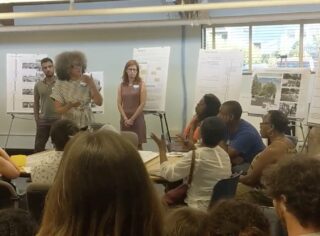
The City of Portland is once again headed back to the drawing board for their Lloyd-to-Woodlawn Neighborhood Greenway project. Back in March, the bureau of transportation dropped a proposal that would have used 7th Avenue as the main, low-stress bicycling connection between the forthcoming carfree bridge in the Lloyd District and the ever-growing Woodlawn neighborhood. Saying they, “Underestimated the role [7th Avenue] plays in the hearts and minds of Portland’s black community,” PBOT switched their proposal to 9th Avenue.
Now, after a meeting with residents of the King Neighborhood on July 25th, PBOT says even their latest proposal for 9th lacks support and won’t be advanced until changes are made.
In an email sent to meeting attendees on July 31st, PBOT wrote: “It is clear that we missed the mark with the proposal and that there is little support in the community for the traffic pattern changes as proposed. Given the response last week it is unlikely we will be advancing the proposal we developed… PBOT is committed to working with neighbors to identify changes that can improve safety for everyone, and to do so in a way that is less disruptive for the community.”
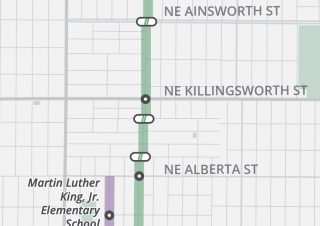
This “disruption” seems to hinge on two diverters planned between Alberta and Killingsworth that would reduce access for auto users and make 9th a “family-friendly, low-stress” place for walkers and bikers. I was not at the meeting last month, but there appears to have been vehement opposition to those diverters (and other aspects of the project) based on PBOT’s email, subsequent statements from the agency, and accounts from people who were in attendance.
Advertisement
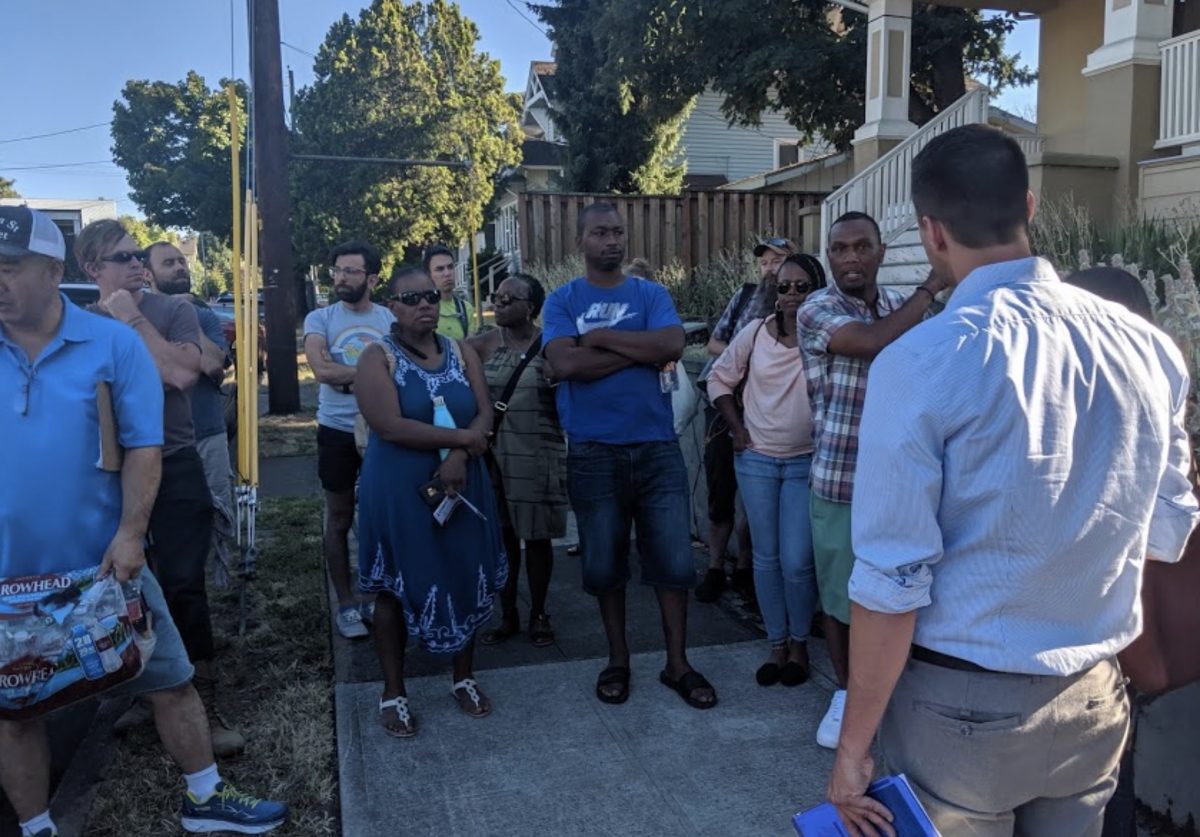
“A whole bunch of people in this room are insisting, ‘This is not good for me!’ But you’re insisting, ‘But this is for the betterment of you,’ when I’m telling you it’s not good for me.”
— Meeting attendee
In their email, PBOT acknowledged several concerns they heard: “Concerns about the planning process and wanting an opportunity to shape the project; Concerns from residents on nearby streets about accessing homes and streets; Desire to continue to use NE 9th Ave by car to reach NE Killingsworth St; A general sentiment that the changes were too dramatic given the scale and goals of the project.”
I’ve seen videos of the meeting where attendees are shouting at PBOT staff. In one of the videos, a woman says, “A whole bunch of people in this room are insisting, ‘This is not good for me!’ But you’re insisting, ‘But this is for the betterment of you,’ when I’m telling you it’s not good for me. And I’ve got a whole lot of other people saying the same thing. But you’re insisting it’s for the betterment of me because in the long run I will see that it is, Instead of asking me.”
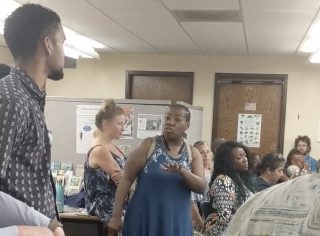
In another video a man and a woman claim PBOT failed to notify them about the project. “We got one note, then we had to inform a school because they didn’t even know [about the project],” a woman said. A different clip showed a tense exchange with a PBOT staffer where a woman said with exasperation, “We don’t need another bike path in northeast!”
The project was slated to begin construction next year. Asked if that timeline still holds following the meeting, PBOT said, “We are definitely not starting over or putting things on hold.”
PBOT Communications Coordinator Hannah Schafer claims the emotional disagreements at the meeting were only focused on a small segment of the project (Alberta to Killingsworth) and that, “This is just part of the standard design refinement process.” As for the segment between Alberta and Killingsworth that’s causing the most concern, Schafer said, “Our traffic engineer is reexamining this segment to see if there may be an alternative proposal that can support the greenway and also respond to what we’ve been hearing from neighbors.”
While diverters claimed most of the attention, PBOT says neighbors expressed support for speed bumps and safer crossings on busy streets.
“We have more work to do,” PBOT wrote in their email, “and we will be hosting additional meetings to listen to neighbors, share more about the project and discuss potential alternative design concepts.”
It’s hard to watch this unfold and not think of the emotions and dialogue around racism and gentrification PBOT faced eight years ago during the North Williams Avenue project. Did PBOT learn anything from that experience?
Were you at the July 25th meeting? If so, let us know your impressions. And stay tuned for notice of future meetings.
— Jonathan Maus: (503) 706-8804, @jonathan_maus on Twitter and jonathan@bikeportland.org
Never miss a story. Sign-up for the daily BP Headlines email.
BikePortland needs your support.


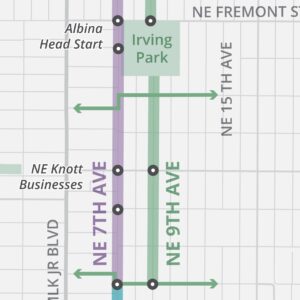
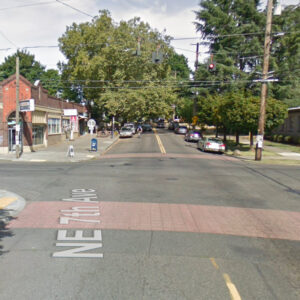
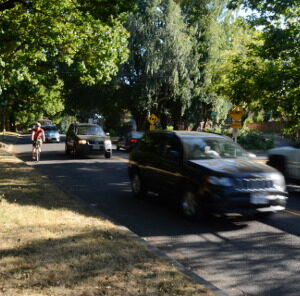
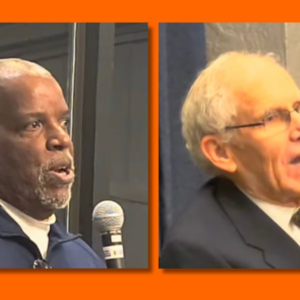
Thanks for reading.
BikePortland has served this community with independent community journalism since 2005. We rely on subscriptions from readers like you to survive. Your financial support is vital in keeping this valuable resource alive and well.
Please subscribe today to strengthen and expand our work.
and if PBOT can get around neighbors who aren’t thrilled about a bikeway through the park, they still have to get Parks & Rec’s blessing.
Does anyone have any more information about PBOT’s plans to get a route through Irving Park? When PBOT did the ole switcharoo from 7th to 9th, they conveniently left off that connection, using some weasely language about that part being figured out with PP&R at some future date. Which means that the official proposal comes complete with a 2-2.5 block gap in it fo people of bike to just figure out their own route. I could never figure out how PBOT could be so incompetent that they would propose a9th as an alternative without having an approved concept for this connection! It looks like there are 3 option, and they are all terrible:
1. go around the park using 9th-Siskyou-11th-Beech-9th. it adds 4 blocks to the route
2. path through the middle of the park- this is the WORST idea and I hope to god this does not happen. This will fundamentally change the nature and circulation of the park, negatively impacting the entire park park experience and specifically impacting the playgournd, 3 play fields and a bunch of trees, easpecially on hte north side of the park where there will need to be significant grading to get the path down to street level.
3. run the path around the perimeter/east side of the park. This is better than through the middle of the park, but the path would have to be be fairly far in from the edge to avoid impacting the trees, so it would impact the play fields.
I am disappointed that PBOT did not take the tact of addressing community concerns at specific locations along 7th, since that route would have provided a direct and COMPLETE route.
Yeah, maybe if we said, ‘what does Irving Park need?’ about the last thing would be, ‘a major bike route slicing through the middle of it.’. The park is on the end of my street and sometimes I ride through there at a jogging pace. It takes a couple of minutes max so no big deal. However, I would never go that if what I wanted was to really get someplace. That solution just doesn’t feel right. What makes sense on a map doesn’t always work on the ground.
> “[#2 a route through the park] will fundamentally change the nature and circulation of the park, negatively impacting the entire park park experience and specifically impacting the playgournd”
Huh? a lot of us ride our bikes through the park every day right now. The park seems to be fine. I enjoy going through the park. It doesn’t seem like the people, the dogs, or the kids seem to mind.
This seems like a really stupid way to run a city. Didn’t we go through all of this during the Lincoln/Harrison diverter drama last year? It seems like there’s plenty of data regarding how diverters impact traffic on neighboring streets (compared to speed bumps or just maintaining the status quo.)
And this “oh well, back to the drawing board” type resolution has real financial impact. We’re all paying for these constant rounds of community outreach, planning sessions, drawings, whatever. I honestly don’t even care anymore. Stop funding these endless planning and study sessions and just re-allocate the money to keeping the community centers open.
I’m relatively new to advocacy and I have to say I don’t know how some of you keep your spirits up. It’s draining.
Aye, it is draining. Successful advocates tend to have a lot of patience, fortitude, and very thick skins. You have to build alliances with people you might not normally like. Be willing to try new innovative advocacy techniques, sometimes even illegal and/or dubious strategies. Publicly praise the wicked and condemn the innocent (no good deed ever goes unpunished.) It’s a thankless task, but I will confess I cried when I saw my first sidewalk infill project completed by PBOT (SE Stark near 130th).
Interesting that they wouldn’t include Eliot which is bordering across the street.
The school there is Boise-Eliot/Humboldt.
Incidentally, I could not find a “Friends of Powell Park”, so Irving Park may not be alone. But then, there are things about Powell Park that make it difficult to befriend.
Disappointing indeed. This is such an important bike/ped corridor to get right for the neighborhood but also for creating a more balanced, equitable, climate resilient transportation system in inner NE and Citywide. How else will we make cycling safer and more inviting for the general population of potential cyclists (the “Interested but Concerned”) as the neighborhoods become more dense?
Watching this from afar, it certainly looks like there is not a critical mass of smart, experienced leadership in City Government that learned from North Williams experience. But it is easy to heap all the blame on the planning staff who may have been set up to fail. I wonder if a lack of dedicated, thoughtful, and strategic leadership in the community isn’t the deeper problem. Most truly innovative things that happen in Portland result from strong leadership simultaneously inside and outside City Bureaus… when the City supports smart, thoughtful community leaders on the outside who in turn support strong, thoughtful government leadership on the inside. The latter is hard to muster when the community is divided and or growing less cohesive. The winnowing out more civic-minded middle class residents who can no longer afford to live in NE, means that these neighborhoods don’t have the civic leadership they use too. A solution may be in building civic leadership, education, and community into the planning and design process. It seems like this is kind of happened eventually on North Williams as failures and controversy forged a deeper, broader conversations that in turn allowed a solution to emerge. My hunch is that could help this organic process along to resource the time and expertise of those who can least afford to participate, learn and make an impact and not let the loudest, ablest participants to dominate the discourse.
Words used to describe “pro-diverter activism”: smart, innovative, civic-minded, community
Words used to describe opposition to diverters from black residents: loud, divided, less-cohesive
They don’t call them white lanes for nothing.
What about black supporters, soren? I am one such person and tired of language designed to isolate dissenters from the false narrative of community consensus.
Champs, my critique of Jim’s post (whom I’ve met in real life) was focused on tone, not on his position per se. This sentence, in particular, annoyed me:
“ablest participants to dominate the discourse.”
I support diversion as a traffic-calming tool.
If I were still involved in transportation activism, I would want to listen to you and elevate your voice.
Why would Champs need you to elevate their voice?
Generations of racism and classism have created systemic transportation (and housing) inequity in Portland. I’m unapologetic about my desire to SUPPORT voices that are underrepresented in our city’s decision making processes. Given your perennial denial of the continuing impact of racism and classism on this city’s policy deliberations, I’m not surprised that you would question this.
I don’t deny our history (which is more complex and nuanced than the simple narratives that get trotted out these days), but I also give people enough respect to think they can speak for themselves without “elevation” by white people. I’m not going to address this further here — my main point was that, to me, your offer of help, while well meaning, sounded condescending.
You certainly did some creative reading and assigning of my words to specific constituencies.
Running a city by committee doesn’t work. Study the design, learn from past project, and implement. If you wait for every neighbor to give you the thumbs up the best you can ever hope for is a hodge podge of designs that no one understands and are poorly used, aka Williams. Not being able to access Killingsworth from 9th avenue is not a reason to stall a project. That is a very easy human pattern to change, you’re in a car for christsakes you can gently push that pedal for an extra two blocks.
On the other hand, building projects that residents don’t like is not a great way to make bike-network expansion sustainable.
1) The dozen or so (?) people who spoke up about “not liking it” are NOT representative of the entire community.
2) In general, people don’t know what they want, and are typically resistant to ANY type of change.
Who is representative of the entire community? If you don’t listen to the people who show up to talk to you, who do you listen to?
Is there any standard of outreach/giving people a voice that you would apply to both this project and those you oppose (such as removing bike lanes from SE 26th or the Rose Quarter Expansion)?
> Who is representative of the entire community? If you don’t listen to the people who show up to talk to you, who do you listen to?
No one is. But—in my opinion—community members shouldn’t get to veto bike lanes/traffic calming. They should get to speak their mind to the city, sure, and make suggestions about implementation and whatnot. But they shouldn’t be allowed to outright veto them.
Bike lanes let people safely bike in the same way that sidewalks let people safely walk. It would be absurd to veto a sidewalk (although I’m sure it happens all time), so why do we let a few angry car-owners say “nope! We don’t want to let people safely bike through our neighborhood?” It’s absurd.
Maybe they didn’t “veto” but instead spoke their minds and convinced decision makers that the project wasn’t ready to move forward.
It is my experience that while people spend a lot of energy wringing their hands over “resident opposition,” (ref. opposition to diverters on Lincoln), in most cases, residents don’t have much of a voice at all (ref. diverters on Lincoln). This project looks to be exceptional in this regard.
I do not think PBOT has a problem with listening too much. If anything, they don’t listen enough.
I would be curious to know neighbors supporting the project attended the meeting.
“The most efficient form of government is a dictatorship.” Harry Truman.
I’d totally be up for it if I could be the dictator.
Agreed, every advancement will be met with reactionary elements. The “car culture” won their rights to drive unabated on 7th, they do not get to win the day indefinitely at the expense of bike riders and pedestrians. At some point, the death grip that the automobile has on our environment needs to be slackened.
It’s interesting how the value placed on community input continues to vary neighborhood to neighborhood.
Knowing how PBOT likes to make their diverters lately, everyone could just drive straight through them anyway.
Add no enforcement, and the diverters are nearly useless.
Fine, let’s just switch it back to the much more direct 7th avenue alignment. We won’t be able to please everyone with either of these options, so we might as well choose the one that will work better.
there’s no 7th between Sumner and Killingsworth. it was always going to be on 9th here.
Turnups. See the route. The 7th plan moved over to 9th somewhere around going I believe.
I believe the 7th plan jogged over to 9th at Sumner, so there still would have been changes to 9th that would impact automobile traffic traveling between Alberta and Killingsworth, which is the primary objection Jonathan is reporting on here.
one of the diverters discussed here would have been south of Sumner, so wouldn’t have been part of the 7th plan, but I’m skeptical that would have made a big difference for the folks with objections.
So disappointing. Many people in this neighborhood would benefit from safer, low traffic streets. I guess too many Portlanders are still firmly in the grip of car dependency.
Sins of the past affecting the future.
Nice quote. I’ll have to remember that.
–for seven generations, according to a bunch of old white guys in 17th century England.
Make them both diverters. Car dominated cultural facilities are institutionalized climate change denialist.
One approach would be to say to everyone in a large area that there needs to be a AAA cycle route in the area and the existence of that somewhere is non-negotiable. Then ask everyone in the area where it should be. Hold workshops, planning sessions, stakeholders meetings, community outreach, etc.
Teach them about the principles of AAA infrastructure so they understand the issues and why this needs to happen. Make sure that people from the neighbourhood that cycle are part of it.
If there has been a history of disenfranchisement then that’s a factor that needs to be addressed. Make the cycle route become part of enfranchisement.
It’s human nature when people feel powerless to dig in their heels and oppose change. By allowing them to have some power over their lives they can feel that they can afford to have change. If they’re part of designing that change then all the better for all.
You would never get consensus, because no one wants it on their street.
I think lots of people want it on their street. I would love to have a major bike route on my street.
If the locals shot down all of each other’s ideas for the greenway, then it would give PBOT the green light to go ahead with whatever plan they like best, because clearly the locals don’t like change, bicycles, or both, so who cares what they think?
I’d use this path, and I already ride on 9th in the area where there’s so much contention about it. I never see cars in that spot, and they should be driving on MLK a few blocks over unless they’re literally only driving to Alberta. But then why would they need to drive at all? Or just drive over to 11th.
I wonder how many cyclists and pedestrians killed by cars it would take before they would be willing to sacrifice some the speed of their cars in order to have safer streets.
I live in a community that is 52% black and 40% white. Over 95% of murder victims are black, over 70% of crash fatalities are also black, and 80% of pedestrians killed or injured are black. My city is particularly dangerous to live in if you are black, but remarkably safe if you are white.
Our city engineers are about 90% white male. When they offer (annually) to start a traffic calming program either citywide or in high-crash neighborhoods, the strongest opposition consistently comes from black neighborhoods (and their respective city councilors) who voice concerns about gentrification and “white-lining” (bike lanes encouraging whites to move in.) The gentrification is already occurring, but it’s not whites moving in, it’s young upper-class blacks who want the bike lanes to get to the nearby universities, people who “sound white”, as they say. According to the census, 55% of our bicyclists are black.
It’s worth noting that many cities started caring a lot more about traffic safety in black neighborhoods after those neighborhoods started gentrifying and more white people started moving in. In some cases, black residents had been asking for safety improvements for years to no avail. I totally get why these folks are suspicious of safety improvements, and why it doesn’t feel very different from all the “urban renewal” programs that have swept through and damaged their communities for generations. It’s on cities to rebuild trust with these communities by having conversations with them first and listening to what they need. And, yeah, having a new set of younger mostly-white people with good intentions leading planning efforts does not mitigate decades of poor treatment and neglect.
Listening to and taking direction from communities is something I want to see the city do more of in all neighborhoods.
Newsflash: people are almost always resistant to making it harder to drive in their neighborhoods if the majority of the residents drive exclusively.
I guess if you’re one of the groups which gets the kid-glove treatment from city hall your voices simply matter more.
Portland is never going to solve these and many other problems if it promises only steps which offend no one.
This is such a continuing disappointment. There was similar outcry over the diverters on SE Lincoln (through a mostly white neighborhood), but the city did persevered, and made a safer cycling facility. Why doesn’t the City seem to care about the lives of black cyclists, too? Just because someone yells at a meeting?
A few tentative conclusions:
1) When residents feel as though something is being done to them, in spite of them, they will push back;
2) CoP is very responsive to concerns of black residents, given Portland’s history of racism (red-lining, etc);
3) If PBOT is going to maintain the illusion of inclusion©, then they must come up with better processes for bringing along residents. Publishing a proposal and calling a public meeting where residents yell at PBOT staff is a recipe for failure.
The opposition to this project is not based on the merits of the design or goals. The project serves as a proxy for gentrification. They can’t do much to stop the wrecking balls or transplants but they might be able to stop a bike lane. That said, PBOT hoping to get buy-in from every member of the community is noble but 9th Avenue does not belong to those who live on that street alone.
It belongs to all of us.
It just occurred to me that if our development policies weren’t so disempowering of residents, they might respond differently to proposals such as this.
Which policies, specifically?
I am having a hard time thinking of even a single way in which residents can have any kind of real influence over development in their neighborhoods, so I’d say all of them.
Aside from, you know, symbolic and ultimately counterproductive acts like protesting diverters in the few communities PBOT feels like it can’t ignore.
For once, I agree with you, Kitty. Just look at how the city handled the infill project. Despite thousands of letters and hundreds of coherently marshaled arguments in opposition, the city is going ahead with what it wanted all along, and instead of incremental change we’ll have radical change. That was the whole point of single-family zoning: you could at least count on some stability in your neighborhood. Not anymore.
Fred: That “stability” of only s.f. houses went away 20 years ago when ADUs were permitted. So already 2 units are permitted on every lot. Yet it was an incremental change. RIP is the next increment. It allows 3 units (or maybe 4 if they’re small). Like ADUs, uptake is not predicted to be that pervasive. And there was as much testimony in favor as against at the last hearing IIRC.
ADUs rarely involve the destruction of existing housing, so represent evolutionary, rather than revolutionary change. But as one of those who will financially benefit from accelerated gentrification, I should probably be more supportive.
Yes, my neighbor doesn’t get a say in how I develop my property, and I like it that way. Ruling by consensus would guarantee that nothing would ever get done.
I agree, which is why I would never propose development by consensus, or any other straw-man like system.
Just because a handful of folks are trying to make this into a racial issue does not mean that it is, in fact, a racial issue. It’s a group of people who want to keep the status quo. They’re using the one effective advocacy tool available to them.
This story reminded me of an article about the Lebron James Foundation, which purchased bikes for inner city kids. Lebron talked about his motivation; namely, that his bike gave him the freedom to get to basketball courts and community centers when he was a kid. (See https://www.bicycling.com/news/a22613790/a-bike-saved-lebron-james-now-hes-giving-them-to-all-his-students/). That could just as easily be the story here, too.
I appreciate that PBOT does community outreach, but it should ultimately pursue policies that will make the streets safer. You will not right the wrongs of racial injustices by scrapping this plan. I would urge them to keep pushing forward. Or, better yet, to revert back to the NE 7th design.
Right, the 9th Ave. alignment was already a disappointment considering the 7th Ave. design.
Honestly, the galaxy brain take is that we shouldn’t be designing new greenways/sharrows anyway and should be advancing to PBLs on arterials (MLK, Fremont, Killingsworth, etc.)
MLK would be ideal for protected lanes if it wasn’t so full of blocks with half a dozen curb cuts for drive-up and drive-thru businesses. It’s frustrating when so many others are ideal, lined with empty parking spaces that my neighbors and customers actively avoid.
Important perspective is that the area near 12th between Killingsworth and Alberta is so windy already, 9th is kind of the only way through. And not only that, but the connectivity was removed within living memory, and not for traffic calming reasons… I can see how residents would not appreciate being on the receiving end of something like that again. Even if this time technically the road is still passable by bikes, to the residents i can imagine its lie the fence across Emerson at 14th.
I used to ride 9th with my two kids between Going and Rosa Parks almost daily during rush hour, and I did not find it very stressful. A few street improvements such as marked crossings and some traffic taming infrastructure to reduce speeding seems sufficient to me for that stretch. The winding road itself makes it hard for drivers to go very fast there.
I wonder if those opposed to this project are the same people that have complained about PBOT ignoring their neighborhood over the years. If so what type of changes do they want to see? If not where were the people that have been demanding improved infrastructure?
“If not where were the people that have been demanding improved infrastructure?”
Most ended up getting priced out of their neighborhoods. As a result, some moved to East Portland, Gresham, Gladstone, and other relatively “affordable” areas of the metro area. Some are part of the growing homeless population. But many simple left Oregon altogether. I’ve met many black Portlanders here in Greensboro NC and other regional cities out here, from Boise, Elliot, Kenton, Sabin, and other parts of Central Northeast Portland, the areas were blacks were allowed to live. In general, they miss Portland and its weather, but they don’t miss its subtle pervasive racism and rapid gentrification. (We have racism here too, of course, but unlike Portland its publicly recognized, more or less out in the open, and widely discussed.)
So are you saying there’s no one around 7th and 9th anymore that want safety improvements and for PBOT to “stop ignoring” them? Are the only people left from 20 years ago ones that don’t want any improvements from PBOT?
And, sadly, the housing “solution” championed by many cycling advocates is laissez faire deregulation that will incentivize more gentrification.
There are multiple long-term active transportation advocates who struggle with houselessness. This is one of the many reasons the bike portland comments section is such a toxic environment.
Yet you post here often and dominate this “toxic” environment…
There are some who’s opinions get moderated, censured, etc, here, yet you get away with whitesplaining, and generally making derogatory comments aimed at the entire community..
Go Figure why you are allowed to post…
When people oppose additional access and safety for peds and cyclists they often will use any argument they can except the honest one – they want to continue to drive everywhere and anywhere as unimpeded as they feel they’re entitled to. The same people against a 7th av route will likely also be against a 9th av route.. . or any route if they’re honest. This cannot be admitted so all sorts of red herrings must be conjured, be it sudden concern for emergency vehicle access, poor victimized motorists who will then speed in retaliation, racializing bike lanes as a white peoples thing imposed on blacks, concern for car diversion onto other streets and on and on. Some are quite creative.
It’s understandable: to blatantly say out loud that despite the state of traffic, air quality, climate change, fatality and injury someone still demands to drive everywhere unimpeded and pretend it’s still 1970… well that doesn’t sound like a credible argument even to themselves! Hence the construction of every concern other than the 900lb elephant in the room.
Probably safe to say some feel that bike lanes are for young white yuppie couples or some other such stereotype. And it’s true that in the US cycling hasn’t been much a part of African American life due to historical and systematic racism among other things. But look at bike lanes in Washington DC and other places that have been in place awhile and you’ll see minority communities also embracing the bike. (well, DC is majority black!) As the climate emergency worsens and quality of life in US cites continues to deteriorate it will become clear to all what the priorities should be – and it won’t be for single occupancy motor vehicles regardless of the ethnicity, age, income or address of the driver.
Ok, let the accusations begin about how insensitive l’m being!
I confess to being grumpy about the diverter at Michigan and Skidmore, but my recent trips through that neighborhood have shown me that I was wrong, there is a lot less traffic on Michigan. It feels like a local street.
When I ride through NE 9th N of Alberta, the biggest problem I encounter is actually crossing Killingsworth.
Maybe one diverter on NE 7th somewhere around Sacramento would tame that street pretty well and we could all get back to wishing baseball games were about 40 minutes shorter.
Seriously, Champs needs a white person to “elevate” him?
Talk about whitesplaining….
Oh man, where to start…
First off, the start of this article is very misleading. I was hugely disappointed that PBOT gave up on the 7th alignment for this greenway, since I used to ride 7th daily and think that suggesting that 9th would somehow become a better option after a few coats of paint is nonsense, but the diverters being discussed here have nothing at all to do with the alignment change. Both the 7th and 9th alignments were going to cut over to 9th a block north of Alberta, because 7th ends in a T intersection before Killingsworth. These diverters would be on the line either way.
Second, as someone who lives less than a block away and walks/bikes this exact place regularly, diverters here are pretty much worthless. The biggest challenge to a continuous bike greenway through this neighborhood isn’t the cars that are sharing 9th, it’s the fact that it’s nearly impossible to cross Killingsworth here during rush hour. NE Killingsworth and 9th NEEDS a traffic light, plain and simple, otherwise it’s always going to be a place where only the bravest cyclists are willing to cross. Either that, or diverters on Killingsworth (which I know is only in my dreams).
Why does the suggestion of diverters here get so much backlash? Because it’s obviously catering entirely to people who a) don’t live in this neighborhood, and b) aren’t even planning on biking through here, but c) would never be interested in doing anything that affects their ability to drive across town on Killingsworth to get to I-5. PBOT just did some work to pretty up the curb cuts here, but without installing any meaningful traffic control at that intersection it’s useless to talk about doing much else in the immediate vicinity.
I really take issue with the “where are they now??” approach to traffic safety improvement advocacy. If the improvements were needed in years past, they are still needed today. My sister lived 30 years ago on NE Alberta and the area was heavily divested. Safer crossings and greenways were needed among many other investments then. I too lived there for over a decade 15 years ago and chimed in on surveys about the need for an inner NE route for bikes and skateboards that aligned north-south (i.e. either 7th or 9th Ave). I attended the open houses for the 7th/9th Avenue greenway. Is safety and decades of voicing the need for safer infrastructure not worth PBOT’s time?
Can it be progress if we allow an area to remain without safety improvements and a disjointed active transportation system? Each person worried about the impact this will have on the ability to drive a car through the neighborhood should offer proposals for how to create a safe, direct route for school children to walk, bike, skate, run, scoot, etc. from King Elementary on Alberta, the Boys & Girls Club on Emerson, and Irving Park on Fremont. Give them the opportunity to provide a proposal.
As a diverse community of many viewpoints and opinions, we are fighting over crumbs left from decades of divestment. There is a direct route and it is OR99-E a.k.a. Martin Luther King Jr. Blvd (formerly Union) and ODOT holds the keys to it. ODOT for too long has been allowed to run a freeway through a low wealth neighborhood and negatively impact the families living along either side. There is enough right-of-way to develop a safe, direct greenway there but instead we are being forced to bicker with our friends and neighbors over “whose street to sacrifice.” Enough! The answer is there and ODOT needs to stop watching silently from the sidelines.
N/NE Portland was not uniquely ignored by PBOT. SE Portland was as well. ODOT still runs a highway through inner SE (aka Powell Blvd), part of both HAND and Richmond neighborhoods (also MLK (now PBOT controlled), 99E, and further out, 82nd and I-205), and, but for neighborhood resistance (back when they had an actual voice), we would have had a proper I-5 style freeway running right up Clinton. Thank goodness the NIMBYs persuaded the government to build Max instead.